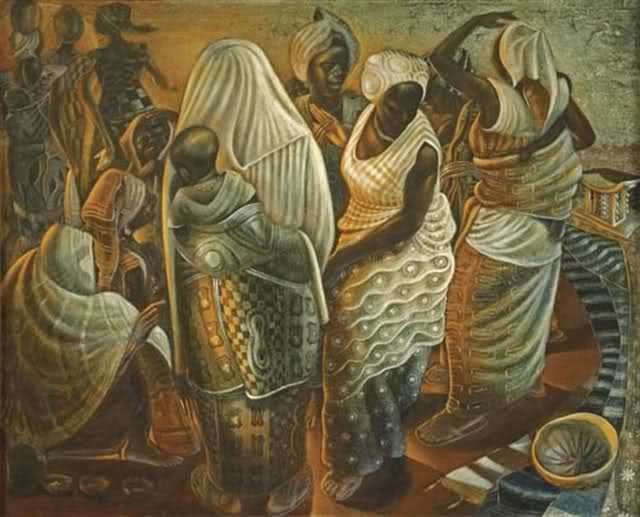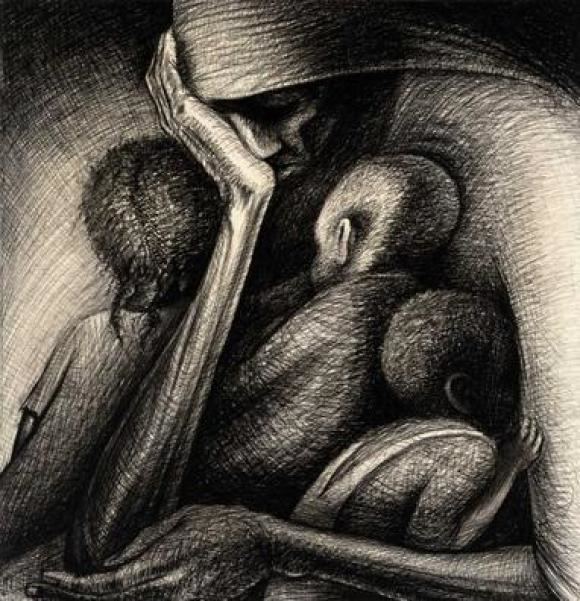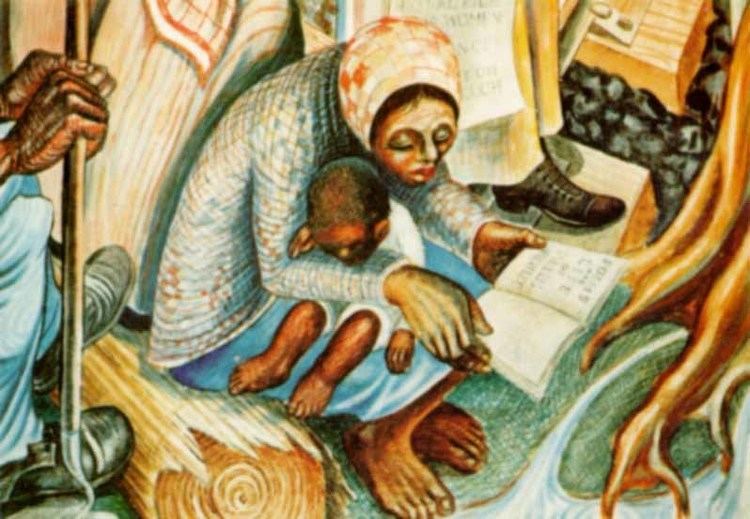Name John Biggers Role Arts Educator | Spouse Hazel Hales | |
 | ||
Artwork Dying Soldier, House of the Turtle, Community Preacher Education Influenced by Similar People Elizabeth Catlett, Charles Wilbert White, Viktor Lowenfeld, Hale Woodruff, Albrecht Durer | ||
John Thomas Biggers (April 13, 1924 – January 25, 2001) was an African-American muralist who came to prominence after the Harlem Renaissance and toward the end of World War II. Biggers has worked on creating works critical of racial and economic injustice. He served as the founding chairman of the art department at Houston's Texas State University for Negroes (now Texas Southern University).
Contents
- Early life and education
- Art Education
- UNESCO fellowship
- Career
- Auction records
- Selected collections
- References

Early life and education

Biggers was born in a shotgun house built by his father in Gastonia, North Carolina. His father Paul was a Baptist preacher, farmer, shoemaker, schoolteacher, and principal of a three-room school. His mother Cora was a housekeeper for white families. The youngest of seven, Biggers was reared in a close family that valued creativity and education. When Cora's husband died in 1937, she took a job in an orphanage for Black children, and John and his brother Joe were sent to Lincoln Academy, an American Missionary Association school in Kings Mountain, North Carolina.

After graduating from Lincoln, Biggers attended Hampton Institute (now Hampton University). Biggers planned to become a plumber (his Hampton application included boiler room drawings), but his life took a dramatic change of course when he took an art class with Viktor Lowenfeld, a Jewish refugee who in 1939 fled from Nazi persecution in Austria before World War II. Lowenfield exposed his students to works by African Americans and was concerned with altering his students' perceptions toward their African heritage by introducing them to the religious and social context of African art, of which the Hampton Museum had a significant collection.

Afterward, Biggers began to study art. At Hampton, Biggers also studied under African-American painter Charles White and sculptor Elizabeth Catlett. There he was introduced to Mexican muralists Jose Clemente Orozco, David Alfaro Siqueiros, and Diego Rivera and American regionalists Grant Wood, Reginald Marsh, Thomas Hart Benton, and Harry Sternberg. He was exposed to and influenced by the Harlem Renaissance artists William Artis and Hale Woodruf, and writers W. E. B. Du Bois and Alain Locke.

In 1943, he was drafted and joined the U.S. Navy, which was at the time segregated. He remained stationed at the Hampton Institute and made models of military equipment for training purposes. In that same year, his talents were recognized when his work was included in a landmark exhibit Young Negro Art at the Museum of Modern Art in New York. Biggers was discharged in 1945.
Art Education
When Viktor Lowenfeld left Hampton to teach art education at Pennsylvania State University, he persuaded Biggers to follow. In 1946, Biggers enrolled at Pennsylvania State where he earned a bachelor's and master's degrees in art education in 1948. In that same year, he married Hazel Hales. He earned a doctorate from Pennsylvania State in 1954. He was awarded an honorary doctor of letters degree from Hampton University in 1990.
His works can be found at Hampton University in Hampton, Virginia, primarily in the campus library. The University Museum at Houston’s Texas Southern University houses a collection of John T. Biggers's works.
In Houston, Texas, Biggers served as the founding chairman of the art department at Houston's Texas State University for Negroes (now Texas Southern University) in 1949. "Over the next thirty-four years Biggers trained the next generation of African American artists and teachers that form a vital part of Biggers's legacy." Mr. Biggers retired from Texas Southern University in 1983.
In 1950, Biggers won first prize for his painting The Cradle at the annual exhibition at the Museum of Fine Arts in Houston. "Segregationist policies, however, allowed black visitors into the museum only on Thursdays, so he could not attend the show's opening." From 1950 to 1956 Biggers painted four murals in African-American communities in Texas, the beginning of his work in murals. He painted many public murals in Houston and elsewhere, including two in 1991 for Winston-Salem State University in North Carolina. Most are still in place.
UNESCO fellowship
Biggers received a fellowship in 1957 from UNESCO, the United Nations Educational Scientific and Cultural Organization, allowing him to become one of the first African-American artists to visit Africa. Under the auspices of UNESCO, he and his wife, Hazel, traveled to Ghana, Benin, Nigeria and Togo to experience Western African cultural traditions first-hand. Biggers described his trip to Ghana and Nigeria as a "positive shock." and as " the most significant of my life's experiences." The African design motifs and scenes of life that he witnessed then were important elements of his work. He returned to Africa again in 1969, 1984 and 1987. In a 1975 Houston Oral History Project interview Biggers spoke of his experiences. "We spent most of our time in the country. People call it “bush,” you know, that’s a name sort of like the hunter. I don’t care for that name for the country people because country people have a great traditional culture. And these cultures are all over the country. They are beautiful. They have endured."
Lowenfeld significantly influenced Biggers's artistic development. Biggers later created works that reflected his perspective of the anguish that people have suffered merely because of their race or religious beliefs. He died at age 76 in Houston.
Career
John Biggers studied African myths and legends and was particularly drawn to the creation stories of a matriarchal deistic system, contrasting with the patriarchal images of the European world. As his ideas and images of Africa melded into the memories of his rural Southern life, his work became more geometric, stylized and symbolic. Quilt-like geometric patterning became a unifying element of his work and color became richer and lighter. However, it is critical to note that over the years, Biggers moved from creating works that were overtly critical of racial and economic injustice (Victim of the City Streets #2, 1946) to more allegorical works (Birth from the Sea, 1964 and Shotguns: Third Ward, 1987).
Robert Farris Thompson calls attention to Biggers’ iconic treatment of household items associated with everyday domestic life, reinforcing the representation of the shotgun house as a symbol of collective dignity and cultural identity. The recurring symbol of the simple shotgun with a woman standing on the porch can be interpreted not only as the simplest type of housing but also as a reference to women, through whom all creation comes. The repeated triangular roof shape reminds one of the pieces of a quilt, a beautiful whole cloth made from many irregular and useless pieces, another symbol of the creative force.
His papers, including correspondence, photographs, printed materials, professional materials, subject files, writings, and audiovisual materials documenting his work as an artist and educator are located at Emory University's Manuscript, Archives, and Rare Book Library in Atlanta, Georgia. In 1994, Biggers illustrated Maya Angelou's poem "Our Grandmothers".
In 1995, the Museum of Fine Arts in Houston hosted a retrospective exhibition of Biggers’s work titled The Art of John Biggers: View from the Upper Room. The show also traveled to Boston, Hartford and Raleigh, N.C. “He is someone who has retained, over 50 years, an emphasis on African-American culture,” said Alvia J. Wardlaw, curator of the exhibition, a recognized author on African American Art, professor and curator of Texas Southern University's Museum. The catalogue Wardlaw created for the retrospective, The Art of John Biggers: View from the Upper Room (published by Harry N. Abrams in 1995), includes a broad selection of Biggers's paintings, drawings, prints, and sculptures.
In 1996 Biggers was invited to create the original design for the Celebration of Life mural in North Minneapolis, a predominantly African American community. The mural was completed by a number of local Minnesota artists, including a few of considerable reputation such as Seitu Jones and Ta-coumba Aiken. Unfortunately, due to the creation of a new housing development the mural was taken down in 2001.
In 2016, The Mint Museum in Charlotte, N.C., opened a multi-year exhibit John Biggers: Wheels in Wheels which includes 12 important paintings, drawings and prints, as well as a rare example of the artist's sculpture. "Through the use of a rich symbolic language and beautiful craftsmanship, Biggers found connections between personal, familial, and regional histories, traditions, symbols, which he wove together to articulate broader cultural and historical concerns," the exhibit promotion stated. Themes that repeat throughout his career - the importance of women, family and triumph over adversity - are evident in the works on display.
Auction records
On October 8, 2009, Swann Galleries set an auction record for any work by Biggers when they sold the painting Shotguns, acrylic and oil on canvas, 1987, for $216,000 in a sale of African-American Fine Art. A stellar representation of the shotgun-style houses found in Southern black communities, the painting had been widely exhibited and was considered a culmination of Biggers’s work. It had remained in a private collection since being acquired directly from the artist in 1987.
